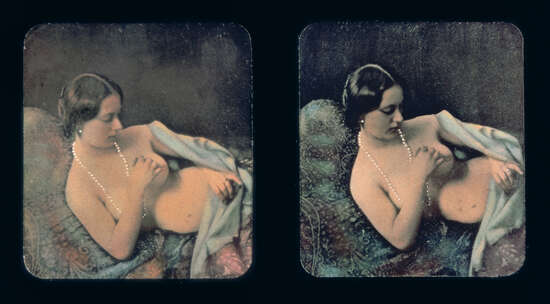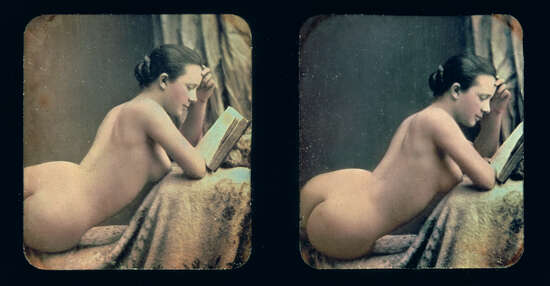READY TO HANG
Out of the box, all LUMAS artworks are ready and easy to hang.
SECURELY PACKAGED
LUMAS works are always packed to the highest standard to make sure it arrives as perfectly as it leaves us.
ARTIST SUPPORTED
Your purchase supports the free and independent work of your favorite artist.
14 DAY RETURNS
Easy 14 day returns to make sure you are satisfied with every purchase.
BACKGROUND INFORMATION
Like his colleague Belloc, New York-born Alexis-Louis-Charles Arthur Gouin started off as a miniaturist painter. However, soon after the discovery of photography, he became one if its pioneers. He contributed his photo plate polishing machine and a light meter to the number of photographic inventions that were feverishly being developed in England, France and Germany. He gained great recognition in the mid-19th century with his tastefully erotic daguerreotypes. The plasticity of post-production coloration and the sensual handling of the incarnate reveal his painting studies at the Académie des Beaux-Arts in Paris, as well as the talent of his wife Marie and daughter Laure Mathilde who both set the course in the studio. When Gouin died in 1855, his daughter, married since 1850 to photographer Braquehais, successfully continued on with the studio at Rue Louis-le-Grand 37 and the tradition of the stereoscopic daguerreotype.
Stereoscope Photos
Only a few years after the invention of photography, researchers set about considering the well-known connection between viewing distance and spatial perception, from the era of Euclid in 4 B.C., through the use of the new medium. A decade after Charles Wheatstone constructed the first apparatus for reflecting two separately photographed and then marginally offset images, which he called the stereoscope, David Brewster invented a camera with two parallel lenses to photograph images with a three-dimensional effect. That they wanted to perfect the optical illusion, and not only perplexing, detailed shapes, but rather the impression of space and depth, is easily understandable. Then there was the virtual inevitability that another drawback of two-dimensional photography was immediately eliminated: the lack of color. Since the investigation into color methods was still in its infant stages, they managed to tint black and white photographs. This bestowed many early stereoscope photographs with a special allure of pale pastels.Eventually, human vision was perfectly simulated. Instead of gray surfaces lying next to each other, which could be visualized as spacious simply because of visual experience, real three-dimensional perceptions, colorful bodies in space, were now available.Female nudes became one of the preferred genres. With these pictures, photographers could gloat in front of their painter colleagues and clearly visualize the “superiority” of their medium: stylistically at the height of the times, more precisely detailed than any paintings, painterly in the color treatment, and all that provided with such an effect that it prompted some to reach out and touch them.
Dr. Boris von BrauchitschVITA
End of 18th century born in New York as Alexis-Louis-Charles Arthur Gouin Student at the Académie des Beaux-Arts de Paris under the painters Girodet and Jean-Baptiste Regnault From 1847 He began his career as a miniaturist and then switched to daguerreotype portraiture. He invented a photometer, among other inventions, and adopted the process for stereoscopy. 1851 He was awarded an honorable mention for his colored daguerreotypes at the world exhibition in London. 1855 He died as a recognized artist and left his studio to his daughter, Braquehais’ wife.





 No thanks, I would like to stay on this site.
No thanks, I would like to stay on this site. Yes, I would like to switch.
Yes, I would like to switch.